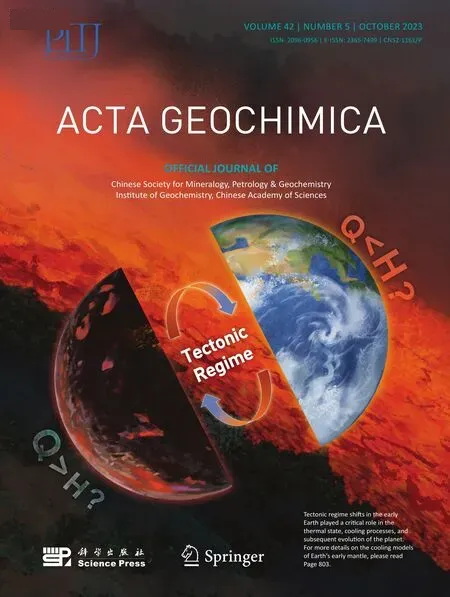Re–Os and Pb isotope features of pyrite in the Shihangli graphite deposit: implications of coal-generated graphite mineralization in central Hunan,South China
Yong Zhang • Dongsheng Ma • Jian-Feng Gao • Jiayong Pan •Xupeng Lv • Guoqi Liu • Fujun Zhong • Xiaotian Zhang • Ying Liu
Abstract The coal metamorphism in Central Hunan provides valuable information about hydrothermal activity and water/rock reactions.Learning how to collect age data on hydrothermal fluid systems is necessary for understanding the history and genetic mechanisms of large-scale coalgenerated graphite deposits.The Shihangli graphite deposit,formed by significant siliceous hydrothermal alteration,is the most distinctive in Central Hunan.Re–Os dating of pyrite from the Shihangli graphite deposit demonstrates that the coal-generated graphite mineralization age is~127.6 ± 3.8 Ma.Based on in-situ mineral analysis,the hydrothermal pyrite in the Shihangli graphite deposit is mostly enriched in Sb,As,Au,W,Ag,Cu,Pb,and Zn.Based on the pyrite Re–Os isochron,the initial(187Os/188Os) values of pyrite were 1.03 ± 0.24 and the Os(t) values varied from 571.8 to 755.1.Pyrite from the Shihangli graphite deposit comprises a Pb isotope composition similar to that of the Madiyi Formation bulk rock and stibnite from the Xikuangshan Sb deposit.Based on the Re–Os,Sr,S,and Pb isotopic compositions of sulfides in the graphite and Sb deposits in Central Hunan,the Madiyi Formation was likely the primary source of oreforming elements (Sb,Au,and As).The Re–Os and Pb isotope compositions of pyrite most likely reflect when large-scale fluid migration and coal-generated graphite mineralization occurred in Central Hunan.
Keywords Pyrite ∙Re–Os ∙Pb isotope ∙Graphite ∙Central Hunan
1 Introduction
The formation of hydrothermal deposits is attributed to the formation of ore-forming fluids.These fluids are usually required in large volumes to form a massive hydrothermal deposit.As a result of large-scale fluid movement,largescale hydrothermal alteration occurs in coal measure strata that are extensively scattered throughout Central Hunan,leading to the creation of endogenetic metal deposits and regional hydrothermal alterations(Dai et al.2022;Fu et al.2020b;Li et al.2022;Ma and Liu 1992;Zhao et al.2021).The Ceshui Formation,a crucial coal measurement layer of the Middle and Lower Carboniferous eras in the Central Hunan province (Wang et al.2012a),experiences coal metamorphism primarily due to regional magmatic–hydrothermal alteration (An et al.2016;Bi 1998;Bi et al.1996,1997).Based on geochemical investigations of trace elements in coal mines,ore-forming elements such as Sb and Ag are notably concentrated in coal,with Sb concentrations up to 45 ppm (Ma et al.2005).The Carboniferous and Permian occurrence horizons of these coal mines are located above the Sb deposit (Devonian).Thus,they may be linked to the fluid circulation mechanism that occurs across the basin and Sb mineralization during the Yanshanian (Ma et al.2005).Over 60% of the land area of Central Hunan,which has hundreds of local coal deposits,is exploited by 40 state-owned coal companies.These deposits included over 90%anthracite(graphite)(He 2008;Mo et al.2020;Zhang 1980).As water/rock interaction has influenced the mineralization characteristics of these deposits on a basin scale,the formation of coal-generated graphite deposits in Central Hunan is likely to result from a regional hydrothermal event.Therefore,the formation age and genetic mechanism of large-scale coal-generated graphite deposits in Central Hunan remain important topics.The Shihangli graphite deposit in the Lower Carboniferous Ceshui Formation is a crucial example of such a deposit,and the pyrite quartz vein in this deposit most likely contains geological and geochemical information on local basin-scale (metallogenic) fluid activity occurrences and graphite mineralization.
Pyrite and molybdenite Os isotopic properties have been widely used to research metallogenic genesis and track the origin of metallogenic components in hydrothermal deposits (Deng et al.2016;Duan et al.2017;Hnatyshin et al.2015;Jiang et al.2000;Li et al.2015a).Additionally,Pb isotope ratio analysis is a powerful tool for exploring the ore genesis and the metallogenetic material origins because it is unaffected by hydrothermal alteration or weathering (Akiska et al.2013;Jemmali et al.2013a,b;Shah et al.2010).The Pb isotope compositions of pyrite can be used to determine the development of metallogenic fluids in hydrothermal deposits and the source of oreforming materials (Wang et al.2017b;Yuan et al.2018;Zhai et al.2018,2019;Zhang et al.2016,2018).The Re–Os and Pb isotope compositions of hydrothermal pyrite can help determine the hydrothermal alteration time and suggest the metallogenetic material sources.
Recently,studies have focused on how the age of largescale fluid movement is constrained and the regional strata modification age caused by substantial fluid movement to form large-scale coal-generated graphite deposits in Central Hunan,China.This study used laser-ablation inductively coupled plasma mass spectrometry (LA-ICP-MS)and inductively coupled plasma mass spectrometry (ICPMS) to identify the date of large-scale coal-generated graphite deposits in Central Hunan.
2 Regional geology
The Jiangnan Orogenic Belt,one of the major polymetallic metallogenic belts in China,runs along the northern margin of the Cathaysia and Yangtze blocks (Li et al.2009;Shu 2012;Shu et al.1995).This belt has several ore deposits,the most significant of which are the Central Hunan Sb–Au–W ore region and coal-generated graphite deposit(Fig.1).The Western Hunan ore deposit,situated in the Neoproterozoic basement outcrop area around Central Hunan,is an Sb–Au–W subzone that forms a part of the Central Hunan ore field,which is Pb–Zn–Sb–Au–Fe–W–Mn metallogenic.The succession of Proterozoic metamorphic and Lower Paleozoic clastic rocks around the basin shows that the Western Hunan Sb–Au–W subzone is an ancient basin (Xu et al.2008).

Fig.1 Sketch map of the geology of Central Hunan Province in southern China (modified overall from Zhang et al.2018c;Au deposits after Kang 2002,Sun et al.2007,and Zhang et al.2015;Sb and Sb–Au deposits after Ma et al.2002)
Granites are most commonly found on the outskirts of Central Hunan.The Indosinian period,which occurred between 225 and 210 Ma,was the peak period of magmatic activity and tungsten mineralization.Many Indosinian W deposits,such as the Dalongxi W deposit (Zhang et al.2014),Zhazixi Sb–W deposit (Wang et al.2012b),and Muguayuan W deposit (Li et al.2018b) (Fig.1),were formed by Indosinian granitic plutons.The Middle and Late Jurassic granites,on the other hand,are ultra hypabyssal;for example,the acid dikes (fine-grained granite and pegmatite veins) of the Baimashan–Wangyunshan granite formed between 170 and 150 Ma(Chen et al.2007;Zhang 2018).
The Longshan Sb–Au deposit,Xikuangshan Sb deposit,and alternating coal metamorphism are all strongly associated with Yanshanian magmatism(such as graphitization and silicification) (An et al.2016;Fu et al.2020a,2016).The Xikuangshan Sb and Woxi Au–Sb–W deposits are two major metal resources in Central Hunan(Zhou et al.2023b;Dai et al.2022)(Fig.1).The Xikuangshan Sb deposit is the largest Sb deposit globally,with more than 50% of the Sb produced and 2.5 Mt of total Sb metal reserves worldwide(Fu et al.2020b;Hu et al.2017;Laznicka 1999;Peng et al.2003a;Yang et al.2006b).The Upper Devonian black shale hosts the Xikuangshan Sb deposit (Fan et al.2004),and the interlayer fault zones of silicified carbonates tightly limit orebodies,the bulk of which are stratiform.The primary stage of Sb mineralization is associated with significant silicic and carbonate alterations,resulting in a substantial silicified alteration halo surrounding Sb orebodies that are often limited by ore-forming fluids (Kuang 2000;Peng et al.2003b;Yang et al.2006a).
In the Early Carboniferous coal age,the Carboniferous Ceshui Formation is a notable coal-bearing deposit (He 2008).A major component of anthracite often undergoes significant thermal metamorphism in Carboniferous coal,transforming it into graphite ore(Li et al.2013,2017).The Shihangli graphite deposit in the Carboniferous Ceshui Formation is an example of a coal-formed graphite deposit(Fig.1).
3 Deposit geology
The Shihangli graphite deposit is situated in the Central Hunan province,~1 km northeast of the Tianlongshan granitic pluton (221.3 ± 1.7 Ma) (Zhang 2018).This deposit is a metamorphic coal graphite deposit formed by regional hydrothermal alteration and has been mined since 1969 (Huang et al.1985).The Lianyuan Coalfield is the major coal-producing region in the Hunan province.The overall architecture of the Shihangli mining zone resembles a roughlynorth–south syncline with asymmetric wings.The stratum is steep,partially upright,and occasionally inverted,with a well-preserved west wing of the syncline.The Tianlongshan granites are located to the west of the Shihangli mining zone.The granite intrusive strata range from the Middle Devonian to the Lower Carboniferous systems,with biotite granodiorite and medium-grained(porphyritic)monzonite granite as the major lithologies.The coal and graphite ore have identical macroscopic features in terms of color and structure,but their hue of streaks differs.Graphite ore has a high density and a dazzling luster,and the fractures are cut or filled by fine quartz and calcite veins (Zhou et al.2017).
The Shihangli deposit has a dip angle of 80°–88° and a strike angle of 240°–251°.The thickness of the graphite ore body ranges from 1 to 4 m,and the footwall and hanging wall of the deposit consist of sandstone to sandy mudstone(Fig.2).The veined and stockwork quartz veins in the graphite ore body range from 1 to 20 cm in width.The frequency of quartz veins decreases as the distance between the graphite ore and the wall rock grows and the silicification and pyritization of the wall rock deteriorate.The silicified alteration zone is typically 1–10 m wide.Pure anthracite graphite ore has high conductivity and a steel-gray glass sheen(Fig.3a).The strongly silicified wall rock has a pyritized vein of fine-grained banded quartz(Figs.3b,c).Since its formation,the Ceshui Formation has undergone three stages of thermal change: deep-seated,regional,and hydrothermal fluid (Bi et al.1996).The hydrothermal fluid developed quartz veins in the graphite ore when the coal seam was changed into a graphite ore body.Simultaneously,the rock on the top and lower walls experienced significant silicification-based changes.When the silicification of the rock surrounding the graphite ore continuously declines with distance,a hydrothermal alteration zone is generated (Fig.3).

Fig.2 Geological cross-section of the Shihangli graphite deposit(after Huang et al.1985)
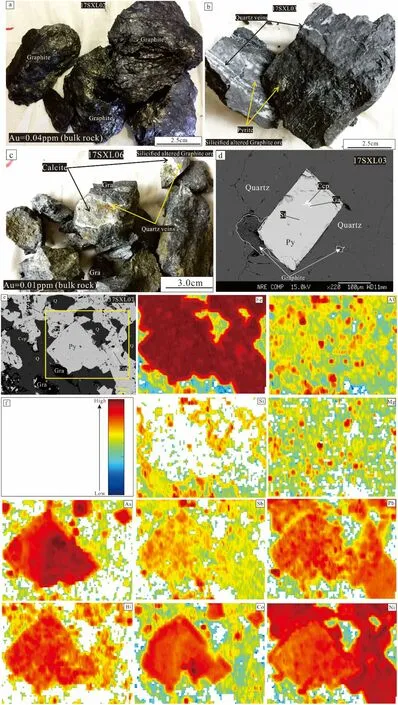
Fig.3 Characteristics of graphite and pyrite in the Shihangli deposit: a graphite;b hydrothermal quartz veins;and c,d BSE images of pyrite grains and LA-ICP-MS maps of selected trace elements in pyrite from the Shihangli graphite deposit.Py-pyrite;Q-quartz;Ccp-copper
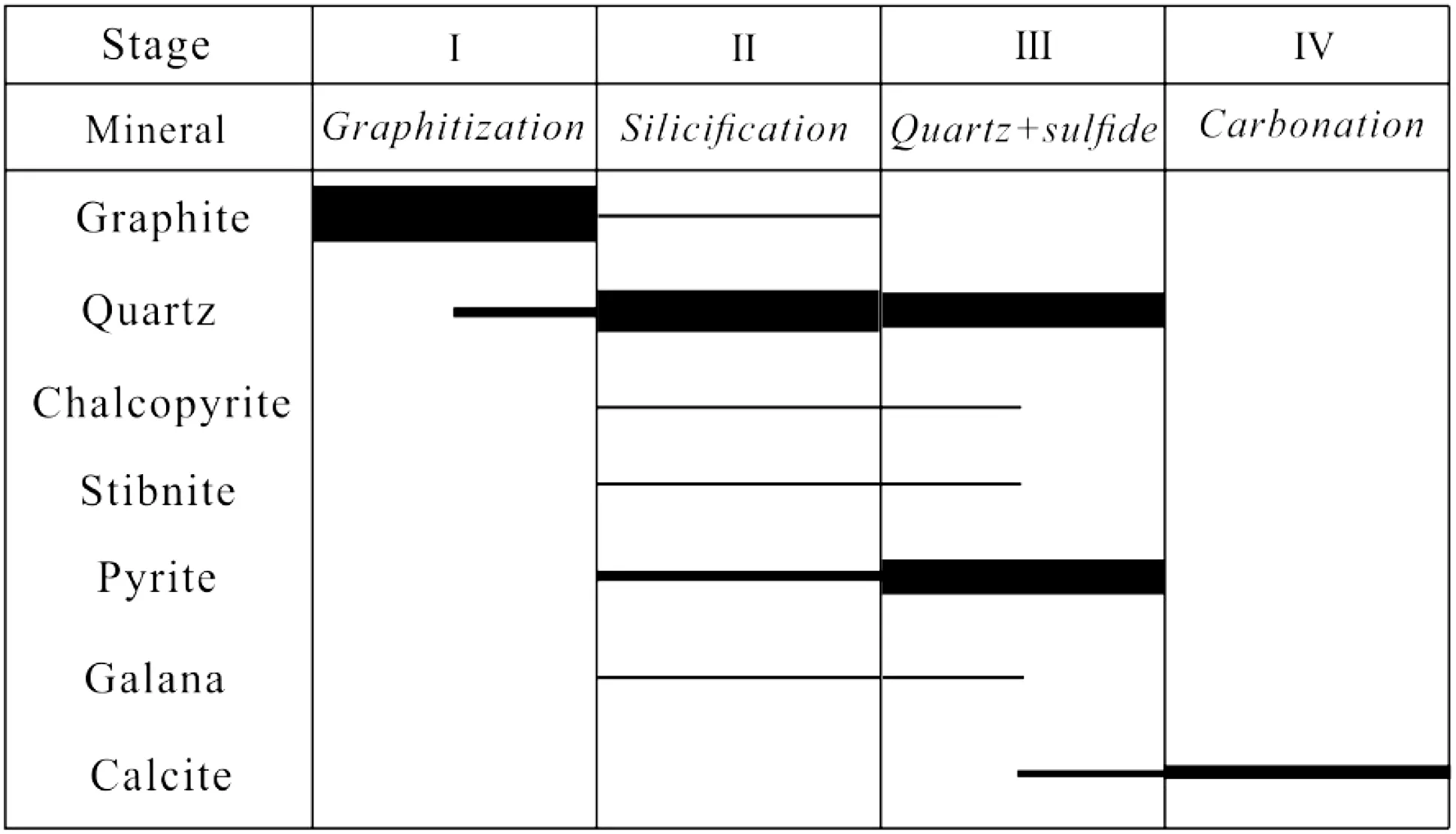
Fig.4 Mineral generation sequence of the Shihangli graphite deposit
The Shihangli deposit comprises graphite ores with block,sheet,and strip structures.The graphite ore has a scaly crystalloblastic structure and is composed mainly of aphanitic graphite,quartz,mica,and pyrite (Figs.3a,b).Based on the results of the chemical analysis,the fixed carbon mass fraction of graphite ore ranged from 64.4%to 87.7% (Mo et al.2020;Zhou et al.2017).Based on the research on trace elements in graphite ores,the principal impurity elements are Sb (50 ppm),Ag (61 ppm),and Au(0.04 ppm).
In this study,the Shihangli deposit was analyzed to determine its mineral paragenesis,which revealed the existence of three major stages of mineralization.Figure 4 summarizes the paragenetic sequence of the ore and gangue minerals in the Shihangli graphite deposit.Stage I of the stratiform graphite ore deposit comprises massive graphite and minor quartz mineralization (Fig.3a).Subsequently,in Stage II,a silicification alteration characterized by significant quartz mineralization in a stratiform graphite ore body with minor pyrite,chalcopyrite,stibnite,and galena mineralization covered and changed this stage(Fig.3b).Stage II was significantly cut and changed by Stage III,quartz–pyrite,which is distinguished by an assemblage of quartz,pyrite,and a small amount of calcite in quartz veins (Fig.3c),which is covered by carbonation(stage IV).
4 Samples and analytical methods
In this study,pyrite from the quartz vein in the Shihangli deposit was investigated (Fig.3b and Table 1).

The State Key Laboratory of Nuclear Resources and Environment at the East China University of Technology in China uses a JEOL JXA-8230 electron microprobe to conduct quantitative chemical investigations on polished thin slices of pyrite.The operating settings were a probe current of 20 nA,a total acceleration voltage of 15 kV,and a pyrite beam diameter of 1 μm.
At Nanjing FocuMS Technology Co.Ltd.,trace element studies of pyrite were conducted using an LA-ICP-MS on polished thin slices.The tests used a combination of the Teledyne Cetac Technologies Analyte Excite laser-ablation system (Bozeman,Montana,USA) and the Agilent Technologies 7700 × quadrupole ICP-MS (Hachioji,Tokyo,Japan).A collection of beam delivery mechanisms homogenized the 193-nm ArF excimer laser before it was focused with a fluence of 6.06 J/cm2on the surface of minerals.A 44-μm spot with a 6-Hz repetition rate was used for the ablation treatment,which lasted 40 s(equating to 280 pulses).The ICP-MS-Data-Cal program used a 100% normalization method without using internal standards to achieve raw data reduction offline (Liu et al.2008).Before each ablation,a 15-s gas background was collected,and spots with a diameter of 44 μm were ablated using an experimental technique at a repetition rate of 5 Hz for 40 s (equating to 240 pulses).Aerosol was efficiently transported by helium carrier gas,which was combined with argon via a T-connector before going into the ICPMS.Sulfides were calibrated using synthetic basaltic glasses GSE-1G and USGS polymetallic sulfide pressed pellet MASS-1.
The trace element pyrite was mapped using LA-ICP-MS at Nanjing FocuMS Technology Co.Ltd.The spot diameter for the ablation technique was 44 μm at 10 Hz,the sample motion was in a straight line at 40 m/s,and the fluence was 3 J/cm2.Before and after sample analysis,background signals were gathered for around 30 s.The NIST 610 or GSE-1G external standard sample was evaluated for 40 s at the start and end of scanning the sample to be tested.Laboratory internal design software LIMS(based on MATLAB design) was used to process the data (Wang et al.2017a;Xiao et al.2018).The software automatically completed background removal and instrument signal drift during the whole analysis procedure.
The pyrite was selected under a binocular microscope to have a purity of more than 99% and then ground to 200 mesh in an agate bowl before Re–Os isotopic analysis.The samples from the pyrite quartz vein were crushed to a size of 60–80 mesh.The State Key Laboratory of Isotope Geochemistry at the Guangzhou Institute of Geochemistry in China conducted this analysis and additional tests where the materials were dissolved in a Carius tube.Re–Os isotope analysis principles and specific analytical steps were taken from previous studies (Shirey and Walker 1995;Li et al.2014,2015b).
The measurements of the pyrite lead isotopes were conducted at ALS Cemex(Guangzhou)Co.Ltd.using ICPMS.The standard procedure was leaching with HCl on a hotplate after digesting 0.5 g of a prepared sample with four acids (HClO4,HF,HNO3,and HCl) until dry.The resultant solution was then cooled,diluted by volume(25 mL) with 10% HCl,blended,and subjected to isotope analysis using a specifically created high-precision ICP-MS isotope analysis technique.Internal rock standards and verified reference Pb isotopes were used to check precision and accuracy.
5 Analytical results
5.1 Mineral chemistry
According to the results of EMPA and LA-ICP-MS major and trace element mapping for pyrite,the Fe content of the Shihangli graphite deposit ranges from 44.3 to 46 wt%,with an average value of 45.57 wt%,and its S content ranges from 50.87 to 53.11 wt%,with an average value of 52.13 wt%(Table 2 and Fig.3).The conventional value is equivalent to the atomic ratio of S/Fe,which generally ranges from 1.92 to 2.03.
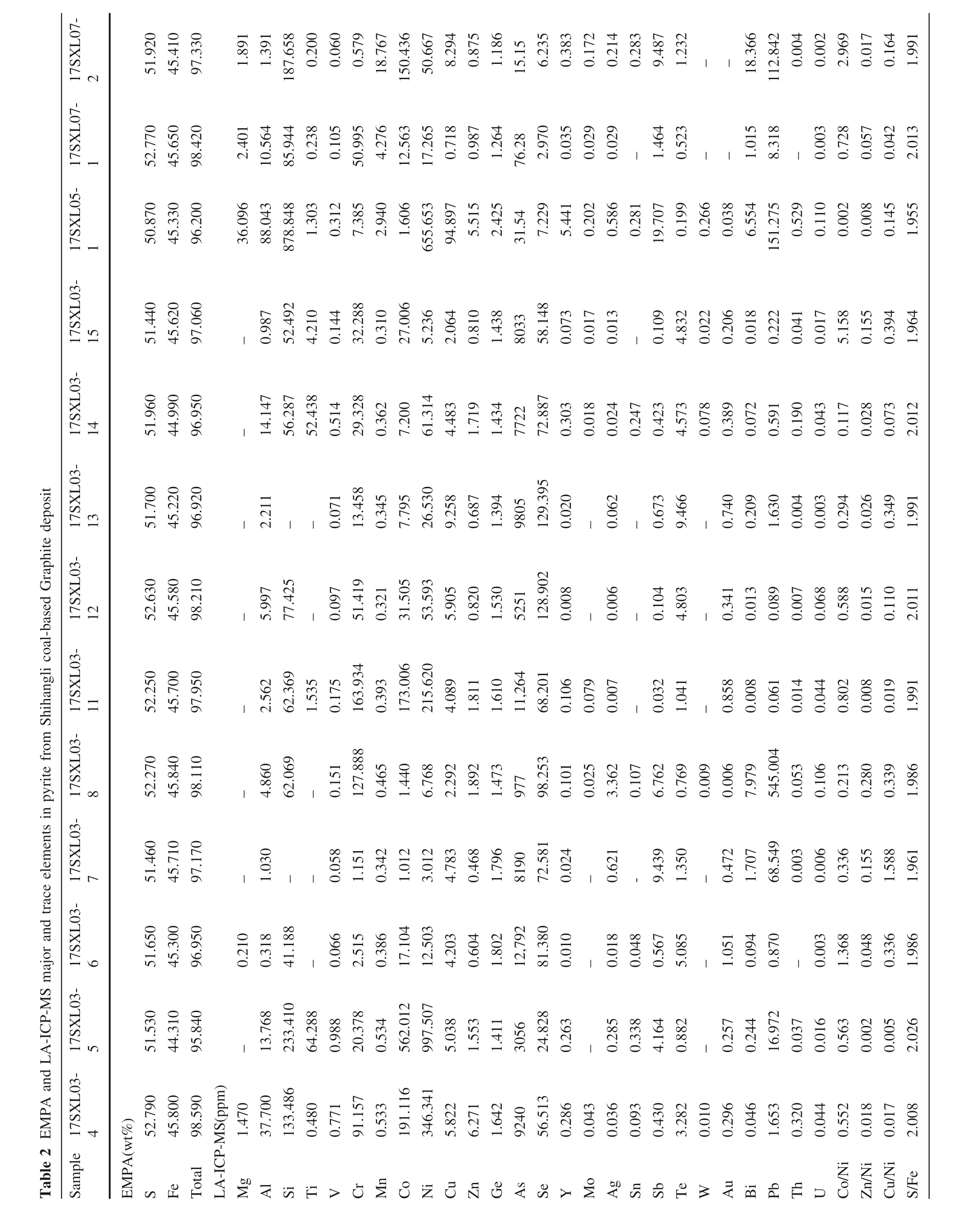
Only 30 of the 39 elements studied were determined,and Ca,Sc,Ga,Rb,Cd,Tl,Ba,and In had element detection limits that had been exceeded.However,the Na,K,Sr,Ba,Mo,and W concentrations in certain pyrite grains were below the detection limit.Other elements,such as Ge,Se,Sn,Te,and W,only vary by one or two orders of magnitude,but the majority of element concentrations vary by three or four orders of magnitude (Fig.2).The pyrite from the Shihangli graphite deposit has a high Co/Ni ratio(mean=1.04 and ranges from 0.1 to 1.59),a high Ni(3–997 ppm),and a high Co concentration (presented in Table 2).
The Sb content in pyrite was similarly over the detection limit,with values ranging from 0.03 to 50.5 ppm(mean=9.18 ppm;typical range,0.53–12 ppm) (Table 2 and Fig.3).Pyrite exhibits considerable As concentrations,ranging from 0.17 to 12,792 ppm (mean=3120 ppm;typical range,12.5–7800 ppm).Pyrite also contains significant quantities of the chalcophile elements Ag,Se,Pb,Se,Te,and Bi (Table 2 and Fig.5).Au values in the Shihangli pyrite ranged from 0.006 to 1.05 ppm (mean=0.20 ppm;typical range,0.04–0.43 ppm),surpassing the detection limit (Table 2 and Fig.3).
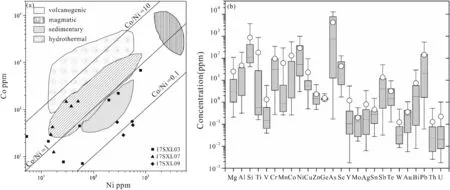
Fig.5 a Co–Ni diagram and b box and whisker plot for pyrite from quartz veins in the Shihangli graphite deposit(a is based on Bajwah et al.1987,Brill 1989,and Xu 1998)
5.2 Lead isotopes
The lead isotope composition of pyrite from the Shihangli graphite deposit is shown in Table 3 and Fig.6.The206Pb/204Pb ratios of the samples range from 18.16 to 18.52,whereas the207Pb/204Pb and208Pb/204Pb ratios are 15.60 to 15.69 and 38.61 to 40.92,respectively.Similar Pb isotope compositions were observed in pyrite from the Shihangli graphite deposit,stibnite from the Xikuangshan Sb deposit,and Madiyi Formation bulk rock (Table 3 and Fig.6).
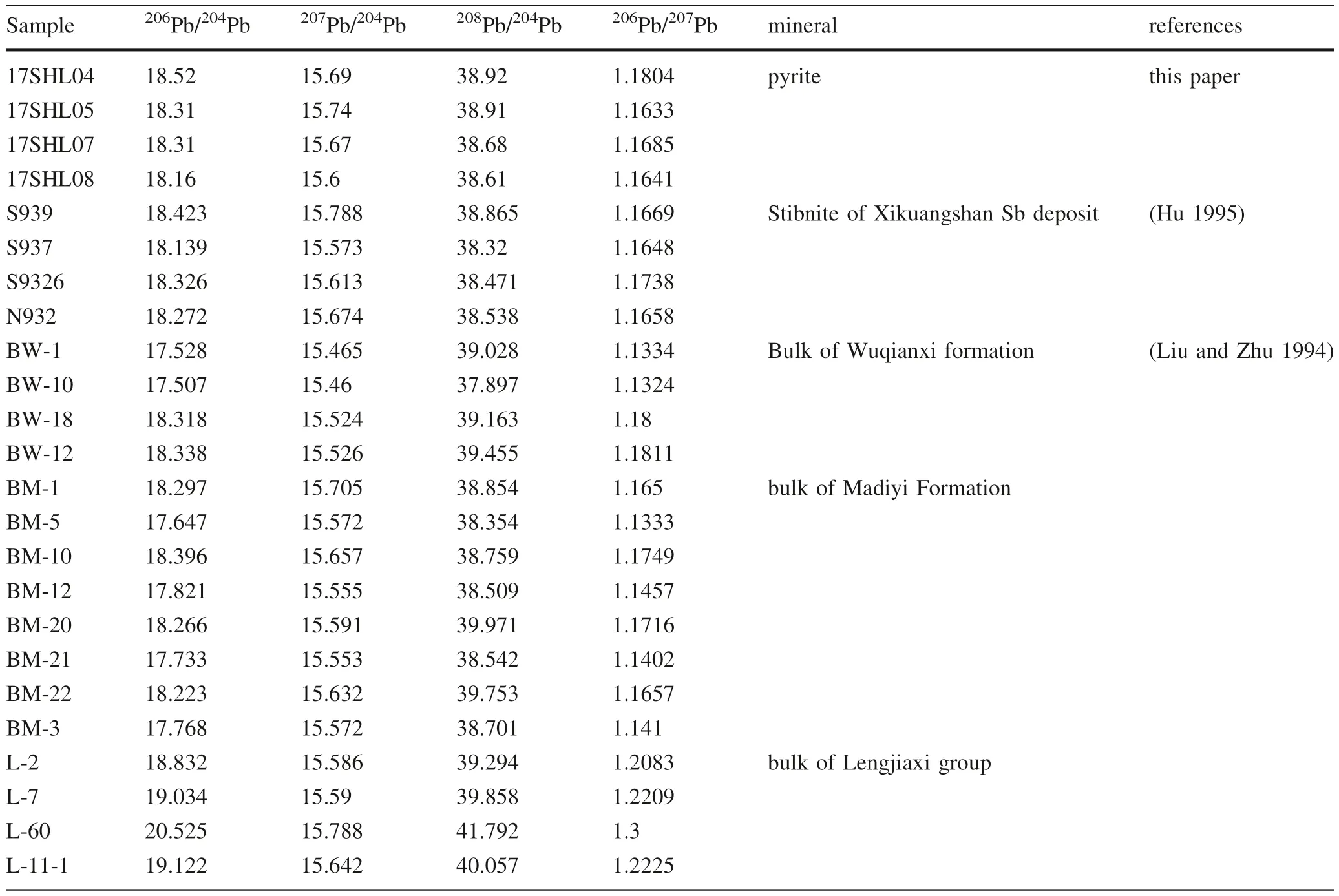
Table 3 Lead isotope systematics of pyrite from the Central Hunan,South China
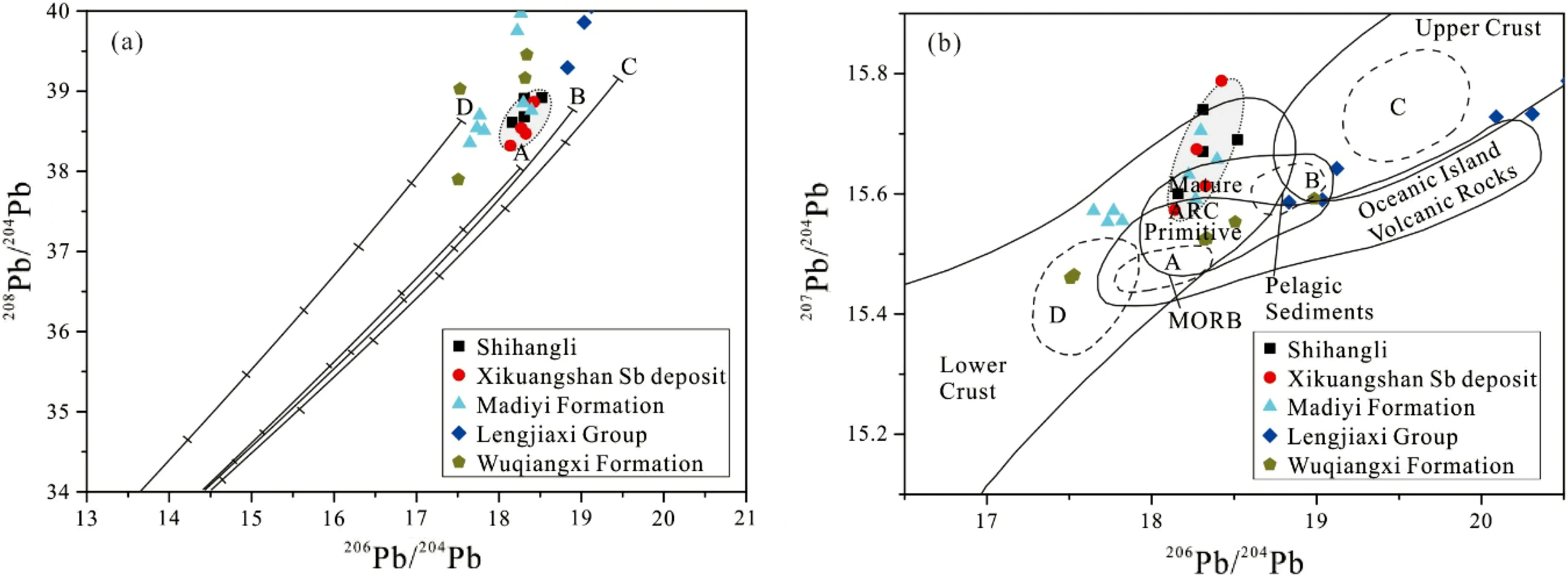
Fig.6 a Pb isotope sources in pyrite,stibnite,and Neoproterozoic epimetamorphic rock in Central Hunan,southern China.b Tectonic model of the Pb isotope of pyrite from the Shihangli graphite deposit (after Zartman and Doe 1981)
5.3 Re–Os isotopes
In pyrite,the187Re/188Os and187Os/188Os ratios were 3027–5754 and 8.09–13.34,respectively,whereas the total Re and Os abundances were 7.37–15.56 and 0.019–0.046 ppb,respectively (Table 4).The samples showed a positive relationship between187Re/188Os and187Os/188Os (Fig.7a).The Re–Os model pyrite ages of Shihangli ranged from 137 to 146 Ma (Table 4),with a weighted mean age of 143.5 Ma(MSWD=1.4).(Fig.7b).The pyrite yielded an individual Re–Os isochron age of 127.6 ± 3.8 Ma (MSWD=1.4,beginning187Os/188Os ratio=1.03 ± 0.24) (Fig.7a).

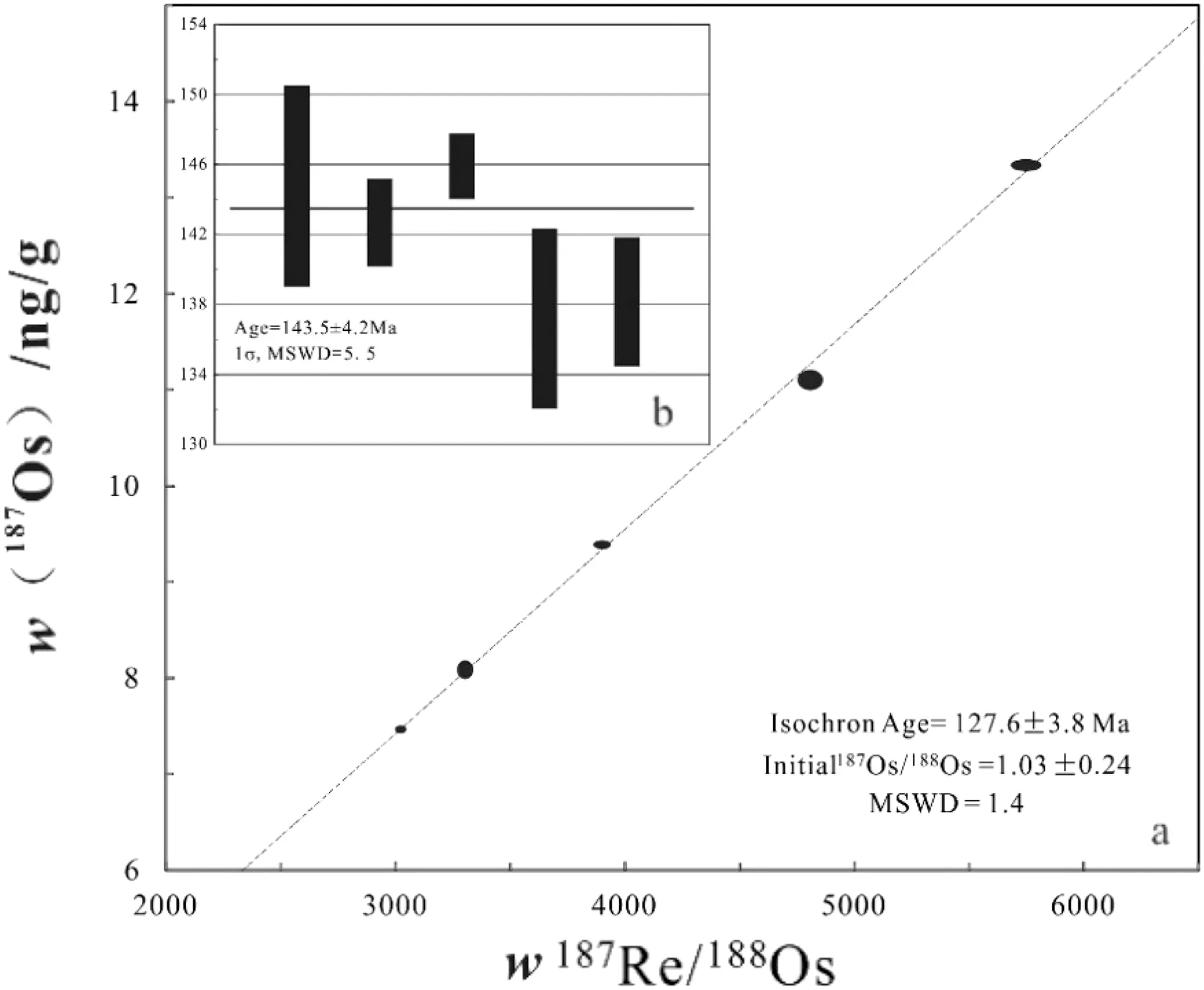
Fig.7 a Re–Os isochron age and b weighted average age of pyrite from the coal-based graphite deposit in Central Hunan,southern China (plotted in Isoplot 4.15)
After the common Os was modified,the Re–Os model age of Shihangli pyrite ranged from 125.3 to 128.1 Ma(Table 4).The age of the Re–Os isochron(127.6 ± 3.8 Ma) was quite close to this figure (Fig.6a).Shihangli pyrite had an Os(t) range of 603.7–792.5.
6 Discussion
6.1 Mineralogenesis of pyrite from the Shihangli graphite deposit
The mineralogy and electron microprobe investigation of pyrite from graphite quartz veins in Shihangli revealed that pyrite is predominantly found in hydrothermal quartz veins(Figs.3a,b).According to in situ LA-ICP-MS trace element tests,the point Sb concentration of pyrite ranged from 0.03 to 50.5 ppm (mean=9.2 ppm,typically between 0.5 and 11.2 ppm) (Table 2 and Fig.5b).The Shihangli pyrite was high in As,with average values ranging from 17.4 to 7800 ppm.Based on research using the LA-ICP-MS trace element mapping technique,the pyrite from the Shihangli graphite mine is usually rich in As,Au,Pb,Sb,and other ore-forming elements (Table 2 and Fig.5b).The Co–Ni diagram shows that most of the pyrite in sample 17SHL07,as well as the typical Co/Ni ratios of 0.1–1.5 for pyrite in the Shihangli deposit,is hydrothermal in origin (Fig.5a and Table 2).The extremely low Se content of this pyrite(ranging from 1.7 to 14.6 ppm),which is comparable to the value of sample 17SHL09 (4.9–8.9 ppm) (Table 2),indicates a hydrothermal origin.The Co–Ni diagram (Fig.5a)shows that some of the pyrites in sample 17SHL03 are of sedimentary origin and may have formed due to a water/rock interaction in coal measure layers.This pyrite is also notable for having a higher Se concentration(between 24.8 and 129 ppm) (Table 2).The pyrite of the Shihangli graphite deposit appears to have formed on a vast scale from an Sb–Au–As rich ore-forming fluid in Central Hunan,South China,when coupled with local metallogenic features.
6.2 Os and Pb isotopes of pyrite trace the origin of ore-forming fluids in Sb–Au mineralization
The initial187Os/188Os and Os values can be used to establish the origin of Re–Os and the proportion of crustal components that enter protomagma(Ackerman et al.2013;Foster et al.1996;Han et al.2007;Jiang 2000).The compositions of pyrite Pb isotopes reveal information on the history of metallogenic fluid in hydrothermal deposits and the origin of the minerals found there.As a result,the Re–Os,and Pb isotope compositions in hydrothermal pyrite may be used to determine the origin of Sb and Au mineralization in Central Hunan.
The initial (187Os/188Os) value calculated from the pyrite Re–Os isochron is 1.03 ± 0.24 (Fig.7a),which is much greater than the value of the Cu–Ni sulfide deposit and any anticipated mantle value but much lower than the typical value found in the continental crust (3.63).Hydrothermal pyrite from Shihangli is radioactively enriched in187Os/188Os (7.47–13.3).Additionally,it is generally compatible with the initial ratio of 1.04 ± 0.16 (Arne et al.2001).In Shihangli,the γOs(t) values of the pyrite vary from 572 to 755(Table 4).This is quite similar to the values reported in the Sudbury Proterozoic Metasedimentary Rocks (844–1054) (Palmer and Turekian 1986),but considerably higher than the average value of what is found in continental crust,which is 3.63 (Walker et al.1991).Consequently,the initial (187Os/188Os) and Os(t) observations suggest that the Re–Os of hydrothermal pyrite from the Shihangli graphite deposit may have come from Neoproterozoic basement metamorphic rocks in Central Hunan.This is consistent with previous findings demonstrating the origin of ore-forming elements (Sb,Au,and As)in basement metamorphic rocks(Ma et al.2002,2003).It was also discovered that ore-forming elements (Sb,Au,and As) were transferred from the basement metamorphic rocks of Central Hunan into the caprock by hydrothermal extraction (Ma et al.2003;Peng and Frei 2004;Peng and Hu 2001;Peng et al.2002).
The Pb isotope compositions of pyrite from the Shihangli graphite deposit and bulk rock from the Wuqiangxi Formation and Lengjiaxi Group are markedly different(Table 3 and Fig.6).However,the Shihangli graphite deposit pyrite has a Pb isotope composition similar to the Madiyi Formation bulk rock and stibnite from the Xikuangshan Sb deposit (Table 3 and Fig.6).Therefore,indicating sulfides of the two deposits probably originated from the Neoproterozoic Madiyi Formation.This conclusion is supported by the fact that the ore-forming elements of the pyrite from the Shihangli graphite deposit and the Sb deposit of the Central Hunan origin from the Madiyi Formation are revealed by Pb isotope ratios of sulfides in the Woxi deposit,Sr and Os isotopic signatures of the Banxi Sb deposit,H–O–S–Pb isotope,and rare earth element characteristics of the Xikuangshan,Dong’an Sb deposit(Li et al.2019,2020b,2022;Zhou et al.2023a;Liu et al.2023).
According to the Re–Os,Sr,S,and Pb isotopic compositions of sulfides in the Sb deposit in Central Hunan,the Madiyi Formation,particularly,may have been the major source of ore-forming elements such as Sb and Au in the Upper Paleozoic strata.
6.3 Re–Os isotopic age of pyrite implication to the timing of large-scale fluid transportation and coal-generated graphite mineralization in Central Hunan
Pyrite mineralization in Shihangli has a Re–Os isochron age of 127.6 ± 3.8 Ma (Table 4 and Fig.7a).The Re–Os age of pyrite is similar to previous Sm–Nd dating of hydrothermal calcite (124 Ma) (Peng et al.2003a) as well as in situ U–Pb dating of calcite (115.3 ± 1.5 Ma) from the Weizhai Sb Deposit (Luo et al.2020).The Banxi Sb–(Au–W) deposit,like the Xikuangshan Sb deposit,is a typical low-temperature mineralization Sb deposit.This deposit is located in the notable Central Hunan Sb belt in South China,where Neoproterozoic epimetamorphic clastic sedimentary rocks contain quartz vein-type Sb-only mineralization (Li et al.2019).Re–Os pyrite from the Shihangli deposit has excellent agreement with the(U–Th)/He age of of zircon (123.8 ± 3.8 Ma),the Rb–Sr age of sulfides (129.4 ± 2.4 Ma),and the Sm–Nd age of sulfides(130.4 ± 1.9 Ma) from the Banxi Sb deposit (Li et al.2018a,2020a),which are thought to date the low-temperature mineralization stage in Central Hunan.This demonstrates that the age range of low-temperature hydrothermal mineralization in Central Hunan is constant.Additionally,this suggests that the Yanshanian hydrothermal activity in Central Hunan has widespread basin-scale characteristics rather than being isolated within the metallic mineral deposit.
Based on the Re–Os dating of quartz vein pyrite,the Shihangli graphite deposit experienced significant siliceous alteration in the Yanshanian.The Yanshanian may have witnessed the transition of coal into graphite in the Lower Carboniferous Ceshui Formation in Central Hunan.Previous research indicates that regional magmatic thermal change (graphitization) occurred in the coal-bearing strata of the Ceshui Formation throughout the Late Triassic and Middle Jurassic(Bi et al.1996).The Re–Os isotope age of pyrite limits the magmatic thermal history of the area to the early Cretaceous.During the early Cretaceous,there appears to have been extensive coal metamorphism and hydrothermal alteration in Central Hunan,coinciding with the regional Sb and Au metallogenic events.
The Re–Os isochron dating of hydrothermal pyrite from the Shihangli graphite deposit demonstrates that significant fluid movement and basin-wide mineralization occurred during the Yanshanian in Central Hunan.The associated hydrothermal events should have occurred after the coal measures were deposited (in the Carboniferous–Permian).However,this age range (125.3–128.1 Ma) does not rule out the possibility that the Ceshui Formation coal measures underwent their initial thermal evolution in the Early Carboniferous and Middle Triassic (Bi et al.1996).The Re–Os isochron age of pyrite (Fig.7a),which coincides with current geological data,dates it to the Yanshanian era.The LA-ICP-MS data also demonstrate that pyrite associated with hydrothermal quartz veins has high As,Au,Pb,Sb,and other ore-forming element concentrations(Table 2).
Consequently,a fluid with a comparable composition to an ore-forming fluid was most likely the source of the quartz vein in the Shihangli graphite deposit.The coal measures in Central Hunan are widely scattered and often exposed to thermal metamorphism,wall rock alteration,and quartz/calcite vein intercalation,implying that hydrothermal superimposition should be a large-scale regional fluid event.In several coal samples,hydrothermal fluid rich in Sb,As,Au,Co,Bi,Pb,and Si may have undergone metamorphism (graphitization) and significant silicification alteration (Bi et al.1996,1997;He et al.2002).As a result of the enrichment and mineralization of scattered elements on a regional scale,small Sb–Au deposits and even exceptionally large Sb deposits were formed due to the migration and expansion of large-scale ore-forming fluids.This research backs up the synchronicity of the Yanshanian ore-forming fluid and the possibility of large-scale fluid movement and coal-generated graphite mineralization in Central Hunan,South China.
7 Conclusions
(1) The Shihangli deposit features Co/Ni ratios greater than 1,with concentrations ranging from 0.1 to 1.5,and the pyrite has a high As level(0.17–12792 ppm,concentrated in 17.4–7800 ppm) and very low Se content (1.7–129.4 ppm).This indicates that the primary pyrite in the Shihangli graphite deposit is hydrothermal pyrite,which is typically rich in oreforming elements such as As,Au,Pb,and Sb.
(2) The Pb isotope composition of the hydrothermal pyrite from the Shihangli deposit is comparable to that of the bulk rock of the Madiyi Formation and the stibnite from the Xikuangshan Sb deposit.This pyrite has a high radiogenic187Os/188Os concentration ranging from 7.5 to 13.3,with an initial187Os/188Os value of 1.030.24.According to the Re–Os,Sr,S,and Pb isotopic compositions of sulfides in the Sb deposit in Central Hunan,the Madiyi Formation,particularly,may have been the primary source of ore-forming elements such as Sb and Au in the upper Paleozoic strata.
(3) Pyrite from the Shihangli graphite deposit was dated using Re–Os (127.6 ± 3.8 Ma),and it is the age of large-scale hydrothermal alteration and coal-generated graphite deposits in Central Hunan.
AcknowledgementsThis research was funded by the National Key Research and Development Program of China(2016YFC0600207 and 2014CB440904),the National Natural Science Foundation of China(Nos.42062006 and 41962007),and the Integrated Exploration Project of China Geological Survey(No.12120114034501).This paper is largely based on data obtained for a Ph.D.project at the Nanjing University,China.We would like to thank the two reviewers and editors very much for their constructive comments.
Author contributionYZ conceived of the presented idea and developed the theoretical formalism after wrote the manuscript.XPL,GL,FJZ,XTZ,and YL helped complete sample processing and testing.DSM,J-FG,and JP contributed to the final version of the manuscript.
FundingThis research was funded by the National Key Research and Development Program of China (2016YFC0600207 and 2014CB440904),National Natural Science Foundation of China(Nos.42062006 and 41962007),and the Integrated Exploration Project of China Geological Survey(No.12120114034501).This paper is largely based on data obtained for a PhD project at the Nanjing University,China.We would like to thank the two reviewers and editors very much for their constructive comments.
Data availabilityThe results from our study is our original unpublished work and it has not been submitted to any other journal for reviews.
Code availabilityThere are no software application or custom code.
Declarations
Conflict of interestOn behalf of all authors,the corresponding author states that there is no conflict of interest.Jian-Feng Gao is editorial board member of Acta Geochimica.He was not involved in the journal’s review of,or decisions related to,this manuscript.The authors have no other competing interests to disclose.
Ethics approvalThis manuscript we wish to be considered for publication in ‘‘ACTA Geochimica’’.No conflict of interest exits in the submission of this manuscript,and manuscript is approved by all authors for publication.I would like to declare on behalf of my coauthors that the work described was original research that has not been published previously,and not under consideration for publication elsewhere,in whole or in part.All the authors listed have approved the manuscript that is enclosed.
Consent to participationWe agree to participate in the arrangement of manuscript submission by the editorial department of the journal.
Consent for publicationWe agree to publish this manuscript.
- Acta Geochimica的其它文章
- The cooling models of Earth’s early mantle
- Petrology of lherzolite xenoliths of Hosséré Sédé volcano(Adamawa plateau,Ngaoundéré area,Cameroon)
- Distribution,risk evaluation,and source analysis of the heavy metals in the sediment deposition of the lower Shichuanhe River,Shaanxi,China
- Decoding the nature of interaction between felsic clasts and mafic magma in a subvolcanic magma chamber from amphibole–titanite transformation and chemistry
- Isotopic analysis based on terahertz spectrum
- In situ infiltration-precipitation processes in some rock systems

